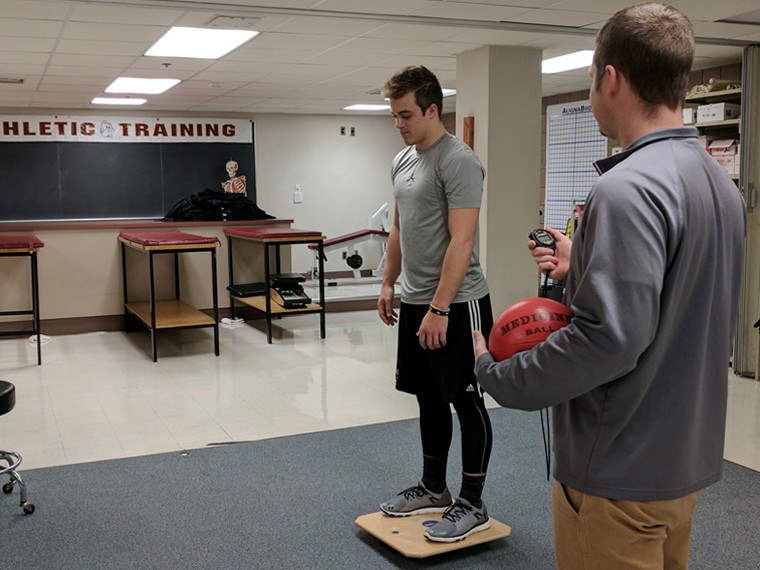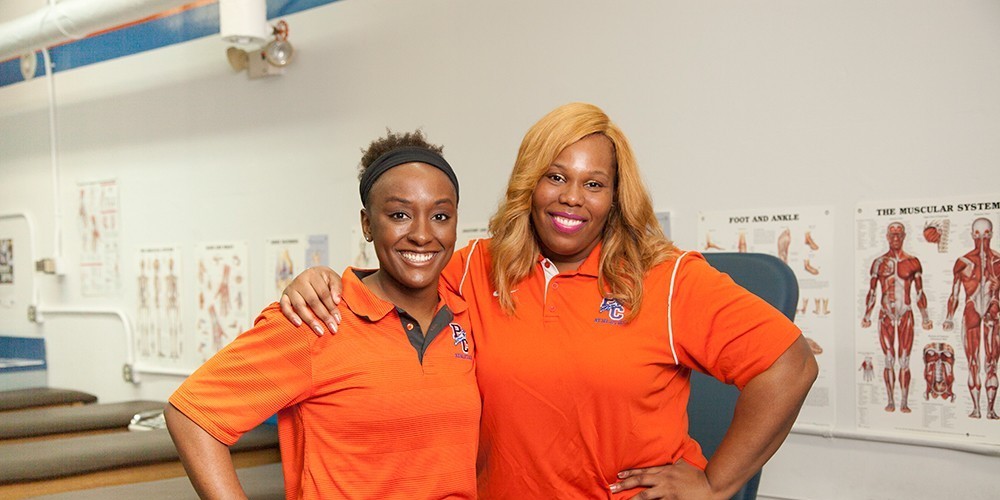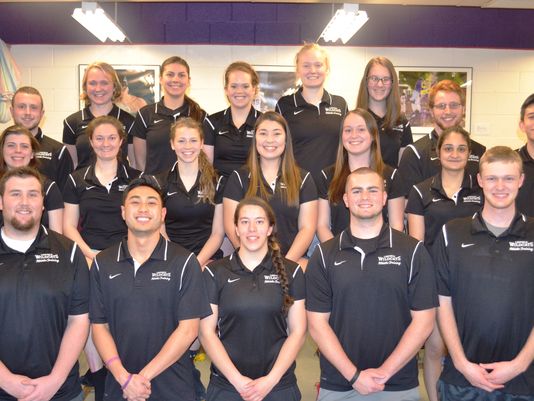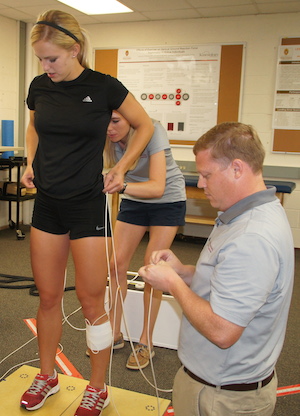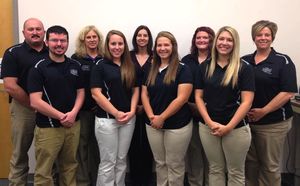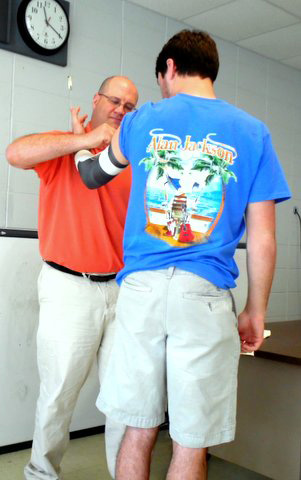
No one wants to have to use their services but, when it’s necessary, athletes sure are happy to see them coming. Athletic trainers are as important to sports teams as the coaches. Their skills and expertise assist athletes’ health and wellness so they continue competing in the sport they love. During the month of March, National Athletic Training Awareness Month celebrates athletic trainers and spreads awareness about all they do for athletes.
Athletic trainer services comprise prevention, emergency care, clinical diagnosis, therapeutic intervention and rehabilitation of injuries and medical conditions. They collaborate with physicians and are recognized by the American Medical Association as health care professionals.

Natalie Snider, a pre-athletic training student, allows a fellow student to practice injury wrapping during a recent class.
Aspiring athletic trainers can start their career path at Gadsden State Community College under the watchful eye of instructor Lance Gilliland. He teaches students enrolled in the College’s Pre-athletic Training Program the skills necessary to prevent, treat and manage injuries that may occur on the court or on the field.
“Being a pre-athletic training instructor certainly has its benefits,” he said. “I love seeing students have that ‘aha!’ moment. I love seeing them grasp concepts and the light bulb go off.”
While in high school, Gilliland witnessed athletes get injured playing sports and thought someone needed to be there to help them. He went to a community college to become a physical therapy assistant but soon changed his focus to sports medicine. He earned a bachelor’s degree from the University of Alabama at Birmingham and a Master’s of Education from Jacksonville State University. He eventually used his training to teach others. A decade ago, he started teaching massage therapy at Gadsden State but later decided to try something different. With the help from now-retired deans Connie Meloun and Dr. Jim Jolly, the Pre-Athletic Training program was born.

Suzanne Haynes practices wrapping an injured muscle on Natalie Snider
“We wanted to create a new health science program that would benefit students and teachers alike,” he said.
“It takes a lot of skill and knowledge to teach others to use a spine board on an athlete with suspected spine or head trauma or a stability ball to increase the strength of an athlete’s injured muscle or cold therapy tubs used to reduce inflammation. Gilliland teaches students to use a deep-heating treatment for soft tissue injuries to increase the rate of healing as well as using moist heat therapy aids to penetrate muscles and increase circulation to aching muscles. Even teaching different wrap techniques is important.
“On Day 1 of class, I send my students home with a roll of athletic tape that has to be brought back to class torn in strips,” he said. “It sounds strange, but there is an art to tearing cotton tape because of the technique used. Students come back feeling comfortable and accomplished after a full roll of torn tape, and they’re ready to begin practicing.”
Taping athletes injured body parts correctly is considered an “art form” by Gilliland. “Every person’s body shape is different and applying flat tape to rippled muscles can get complicated,” he said.
Hands-on experience is essential to athletic training. To help learn about human anatomy and how muscles overlap, Gilliland takes the students outside the classroom to learn, such as going to The Factory in Rainbow City to see how jumping, running and throwing effect each muscle group. A visit to Gadsden State’s cadaver lab allows the students to see the layering of the human muscle and the importance of a great tape job. Students also to go a compounding pharmacy to learn how compounds directly applied to an injury site relieve pain and inflammation.
“The hands-on approach that our program has, shows students how demanding their jobs will be and makes them aware of their strengths and weaknesses so they may prepare for and advance in an athletic training career,” Gilliland said.
Athletes like Courtney Rowe benefit from the Pre-Athletic Training Program by being treated with an electric stim unit and wet heat therapy as maintenance on a recent hyper-extended knee and an old torn meniscus injury.
“The therapy really helps relieve my pain so I can get on with practice and playing the game,” said Rowe, who is a member of the Gadsden State Cardinals volleyball team.
A football injury as a teenager is what led Jarvis Jones to enroll in the Pre-Athletic Training Program at Gadsden State.

Instructor Lance Gilliland demonstrates wrapping an injury on student Brad Montgomery.
“While going through rehabilitation, I became interested in the idea of helping others recuperate from traumatic injuries,” said Jones, who is retired from the Navy. “I enjoyed the conversations I had with my therapist and I valued the services provided to me.”
When he returned to Gadsden after his military service, he knew he wanted to pursue his dream of helping others.
“Gadsden State was close to home and affordable,” he said. “Plus, it had the perfect program to help me begin a successful career in athletic training. I would eventually like to be working on a professional level in the NBA, MLB, NCAA or NHL.”
Helping others is also the reason Gadsden State student Natalie Snider enrolled in the Pre-Athletic Training Program.
“I personally would like to be an athletic trainer on the field to help keep kids safe,” she said. “I was inspired to an athletic trainer when I was young and saw a young girl playing softball take a hard hit to the face. I just remember wanting to help her. I knew I wanted to be the person to help prevent injuries, treat injuries and comfort the players during those scary moments.”
Gilliland said compassion is an important attribute for any athletic trainer along with punctuality, knowledge, and confidence. “They have to have the confidence to continue their education at a four-year university and feel comfortable at a fast-paced, high-stress work environment,” he said. “Last but not least, athletic trainers have to have a sense of humor. Laughter is the best medicine and can help calm your athletes’ nerves and fears so that you can do your job efficiently. Humor helps you be as fresh for a 9 p.m. basketball games as you were at the 9 a.m. baseball game that morning.”
For more information about the Pre-athletic Training Program contact Gilliland at 256-549-8283 orlgilliland@gadsdenstate.edu.
CLICK HERE FOR ORIGINAL ARTICLE
